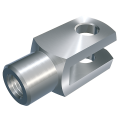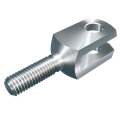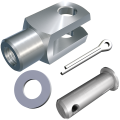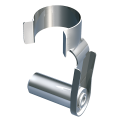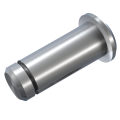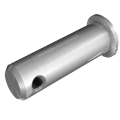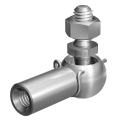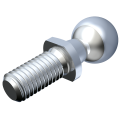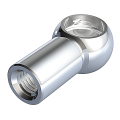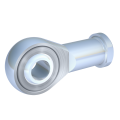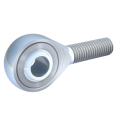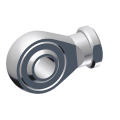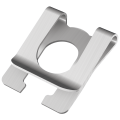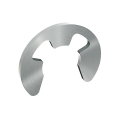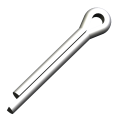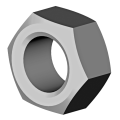描述
1. Product description
The taper key with gip head DIN 6887 is a machine element that serves as a shaft-hub connection. It visually resembles a parallel key, but is beveled with an inclination of 1:100 and is driven into the corresponding groove with a hammer. Unlike the parallel key, where the force transmission between shaft and hub takes place through a form fit, in a key connection the force is transmitted by friction fit on its inclined surfaces in the radial direction. This special design ensures a particularly secure and load-bearing connection. The taper key with gip head thus offers increased holding power compared to the classic parallel key and eliminates potential play that can occur with form-fit connections. Taper keys with gip head DIN 6887 are made from high-quality materials and offer high reliability and durability. They are precisely machined to ensure an optimal and firm connection that withstands vibrations and dynamic loads. Thanks to the positive locking connection, the taper key with gip head enables exact fixation and positioning of components.
2. Product details
Size: 4x4x14 - 50x28x400
Material group: Steel
Surface: bright
Width b: 4 - 50
Height h: 4 - 28
Key height h1: 4,1 - 28,4
Gip height h2: 7 - 45
Length l: 14 - 400
3. Application Areas & Compatibility
Taper keys with gip head DIN 6887 are versatile linking elements used in numerous industries. Their special design and the resulting force-locking connection make them ideal for applications where high precision and load-bearing capacity are required.
Mechanical engineering: In the design of machines and systems, taper keys with gip head are often used to securely connect shafts and hubs and to enable precise movements.
Vehicle manufacturing: Here, they are used in drive trains and transmission systems to ensure reliable power transmission.
Tool making: Taper keys with gip head are indispensable in machine tools, where their precise fit ensures accurate and stable positioning of the tools.
Plant construction: In the construction of industrial plants, taper keys with gip head ensure a secure and durable connection of rotating components.
Automation technology: In automated systems, they contribute to the stable and precise movement of components, which is crucial for the efficiency and reliability of the equipment.
Compatibility: Taper key with gip head DIN 6887 stands out due to its standardized dimensions, which allow for seamless integration into existing systems and components. Their precise measurements ensure smooth interaction with other DIN-standardized components such as shafts and hubs. This simplifies planning and assembly and increases the interchangeability of components. In summary, the taper key with gip head DIN 6887 offers a flexible and reliable solution for precise and stable connections in a wide range of industrial applications.
4. Advantages and Benefits
Taper keys with gip head according to DIN 6887 offer numerous advantages and benefits, making them a preferred choice in many industrial applications. Due to their special design and the use of high-quality materials, they provide the following advantages:
High precision and accuracy: The precise manufacturing of the taper keys with gip head ensures an exact fit, guaranteeing a stable connection and reliable performance. This is especially important in applications where accuracy and precision are crucial.
Secure and load-bearing connection: Compared to form-fitting connections such as parallel keys, the friction-fit connection of taper keys with gip head offers increased holding power. The beveled surfaces ensure a tight fit and eliminate clearance, effectively absorbing vibrations and dynamic loads.
Easy assembly and disassembly: Taper keys with gip head can be installed with simple tools such as a hammer, which makes installation easier. In addition, they are easier to disassemble when needed without damaging the component or the connection.
Low maintenance: The robust and precise nature of the taper keys with gip head minimizes maintenance effort. Due to the solid connection, the components remain in optimal condition for longer, reducing operating costs and increasing productivity.
Universal application possibilities: Thanks to their standardized dimensions and compatibility with other DIN-standard components, taper keys with gip head can be used in a variety of applications and industries. This makes them a flexible solution for many industrial requirements.
In summary, taper keys with gip head according to DIN 6887 offer the combined strength of precision, reliability, and ease of use. They provide secure and stable connections and help improve the efficiency and service life of the entire machine or system.
5. Assembly and Installation
The correct assembly and installation of taper keys with gip head DIN 6887 is crucial for the functionality and reliability of the entire connection.
Below are the steps and important aspects of assembly and installation:
Preparation
Safety precautions: Wear appropriate protective equipment, such as safety gloves and goggles, to prevent injuries during assembly.
Tools: For assembling a taper key with gip head, you essentially need a hammer and, if necessary, a drift pin.
Component inspection: Ensure that the shaft and the hub are free from dirt, oil, and grease. A clean surface is essential for a secure and firm connection.
Installation of the taper key with gip head
Positioning: Insert the taper key with gip head into the designated slot in the shaft and hub. Ensure that the inclination of the taper key with gip head is correctly aligned.
Driving in: Gently drive the taper key with gip head into the slot using a hammer until it is fully seated. Work evenly and avoid excessive blows to prevent damage.
Checking the fit: Check if the taper key with gip head sits firmly in the slot and that there is no excessive movement. A tight fit is essential for the proper function of the keyed connection.
Adjustment and fine-tuning
Fine-tuning: If necessary, slight fine-tuning can be carried out to ensure the ideal position of the shaft and hub. This is done with gentle corrective taps from the hammer.
Removal of the taper key with gip head
Choice of tool: A special key puller is suitable for removal. Position the tool correctly to pull out the taper key with gip head.
Caution: Proceed carefully during removal to avoid damage to the components. Remove the taper key with gip head slowly and evenly.
Maintenance and inspection
Regular inspections: Regularly check the fit and condition of the taper key with gip head, especially after long operating times or under high loads.
Replacement when worn: If there are signs of wear or damage, the taper key with gip head should be replaced promptly to ensure the secure function of the connection.
6. Safety instructions & Standards
Safety during the assembly and use of taper key with gip head DIN 6887 is of utmost importance to prevent accidents and damage.
Here are some safety instructions that should be observed:
Tool condition: Only use intact and suitable tools. Damaged or unsuitable tools can lead to accidents.
Safe working: Always hold the tools securely to prevent slipping, and only use the hammer or assembly drift appropriate for the respective task.
Even blows: Drive in the taper key with gip head evenly and not too forcefully. Avoid overly strong blows to prevent damage to components.
Correct application: Ensure proper alignment and positioning of the taper key with gip head during assembly for a secure connection.
Standards
DIN 6887: DIN 6887 specifies the geometric shapes, dimensions, and tolerances for taper key with gip head, which are used as shaft-hub connections. Compliance with this standard guarantees universal applicability as well as interchangeability of taper key with gip head and thus contributes to optimized compatibility and functionality during installation.

